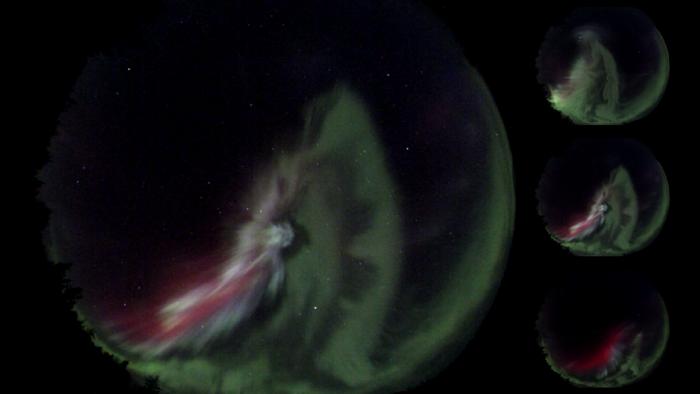A recent breakthrough from researchers at the University of Calgary has unveiled significant insights regarding a mysterious phenomenon seen during the aurora borealis. This peculiar whitish-grey patch that often accompanies the vibrant northern lights has remained largely unexplained until now, leaving scientists intrigued for decades. The team, led by Dr. Emma Spanswick, an associate professor in the Department of Physics and Astronomy, has put forth a compelling explanation for this phenomenon, referred to as “structured continuum emission.”
The research article outlining these findings was officially published on December 30, 2024, in the prestigious journal Nature Communications. The authors delve into the complex association of this structured continuum emission with dynamic auroras—those awe-inspiring natural light displays often visible in high-latitude regions. Dr. Spanswick emphasizes the stark visual contrast one might observe when witnessing these vibrant auroras illuminating the night sky, with dynamic greens and reds painting the heavens, only to be disrupted by this anomalous grey-toned emission in the background.
Spanswick’s description of the structured continuum emission as a persistent heat source offers a rationale that expands our understanding of auroras. The research makes it evident that our previous interpretations of auroras had oversimplified the phenomena, failing to account for the complexities unveiled by this discovery. The insights gained have ramifications extending beyond mere aesthetics; they suggest that our broader understanding of Earth’s atmospheric dynamics is far more nuanced.
Notably, the advancements in camera technology have played a crucial role in this research. Where older camera systems limited the ability to capture the sublime array of colors present in the auroras, recent developments have enabled both amateur and professional photographers to capture true-color images of these celestial displays. This technological evolution has ultimately enriched the ongoing scientific dialogue about auroras and their associated phenomena, allowing scientists to analyze data previously considered too ambiguous.
In the context of this groundbreaking research, the relationship between structured continuum emissions and another specter known as STEVE—an acronym for Strong Thermal Emission Velocity Enhancement—has been posited. Spanswick draws intriguing parallels between the two, underscoring similarities in their spectral elevation while distinctly characterizing them based on their association with the auroras. Unlike STEVE, which manifests as a separate band across the sky, the grey-toned patches are intrinsically tied to the auroral displays themselves, making their identification and analysis more challenging.
The research not only illuminates the mysteries of these atmospheric phenomena but also highlights the contribution of UCalgary students, marking a significant milestone in their academic journeys. Among these students was Josh Houghton, who began as an intern on the project. According to Houghton, he was initially learning the ropes but quickly became integral to the analytical work leading to the publication. This anecdote of active involvement showcases the opportunities emerging from such research, promoting student engagement with hands-on scientific inquiry.
Furthermore, the financial backing from programs such as the Transition Region Explorer (TREx) has been instrumental in facilitating this research. TREx is a collaborative initiative funded by several reputable organizations, including the Canadian Foundation for Innovation and the Canadian Space Agency. The advanced instruments utilized in the research, which include RGB and spectrograph technologies, are pivotal in capturing the intricate details necessary to advance our understanding of these natural wonders.
The relevance of the findings extends to broader implications about what they reveal regarding atmospheric physics. Recognizing the complex interplay between various emissions enables scientists to build a richer model for understanding not only the auroras but the larger atmospheric processes in which they exist. This understanding has the potential to inform everything from climate research to predicting space weather, making the work of Spanswick and her team especially valuable.
Through a comprehensive approach that melds advanced imaging analysis with theoretical exploration, this research contributes to a growing corpus of knowledge. The implications are significant; not only does the research answer lingering questions, but it also raises new ones, inviting further exploration in this fascinating realm of atmospheric science.
As researchers continue to unlock the secrets held within the skies, revelations around the structured continuum emission alongside auroras encourage further interest and study in the field of space science. What this suggests is a natural dance of light within our atmosphere, crafted by the intricacies of physics and endowed with the beauty that captivates both scientists and sky-watchers alike.
The publication of such findings not only highlights the advances made in understanding auroras but also serves to inspire new generations of scientists to explore the intricacies of our natural world. In each shimmering light display, there lies an invitation for inquiry, discussion, and deeper comprehension of the universe around us. Researchers like Dr. Spanswick and her team stand at the frontier of this exploration, where every discovery adds another layer to our understanding of the spectacular phenomena that grace our night skies.
The unveiling of the structured continuum emission is but a stepping stone in an expansive field packed with still-unanswered questions. As technology advances and research methods evolve, we can anticipate new groundbreaking discoveries that will continue to enrich our comprehension of atmospheric phenomena, the beauty of nature, and the broader cosmos in which we live.
Subject of Research: Association of structured continuum emission with dynamic aurora
Article Title: Association of structured continuum emission with dynamic aurora
News Publication Date: 30-Dec-2024
Web References: Nature Communications
References: Not Applicable
Image Credits: Credit: Courtesy Faculty of Science research team
Keywords
Aurora Borealis, Structured Continuum Emission, Dynamic Auroras, Imaging Analysis, Research Breakthrough, Natural Light Displays, Atmospheric Science, University of Calgary, Dr. Emma Spanswick, Technological Advancements, Scientific Research, Student Involvement.






